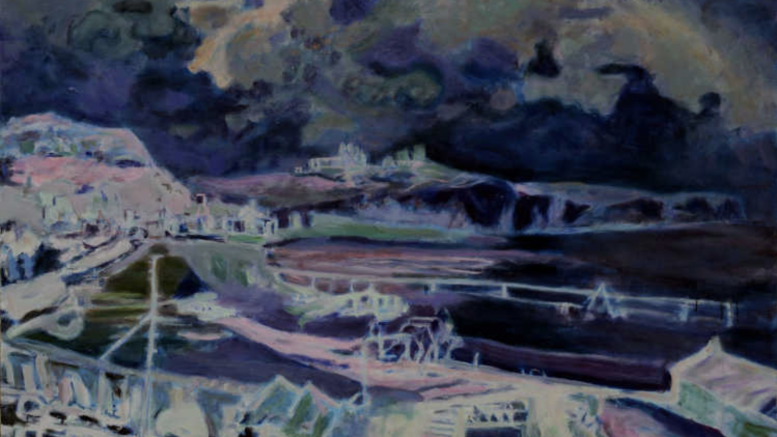By Mishal Baig
Paintings spring from places. Inner or outer. For Trevor Burgess, these places have changed drastically in recent memory. His instalment of paintings called “Inversion”, partly journeys into the inner landscapes of people, how since Brexit, and especially in the midst of pandemic lockdowns, people retreated further into themselves. Other pieces in this set invite the viewer into feeling this similar quality of retreat in natural landscapes, like the eroding cliffs of the Seven Sisters. Eventually, as you needle your way through his collection of paintings, you find how this thread of inversion tugs at people and places in a joint topography.
Gazing upon this piece, Elegy for street life 8, the inwardly-bound cold blue hue of the painting casts an aura around the figures which seems to close in around them, rather than emanate outward as auras normally would.
Oil on aluminium. 40 x 50cm
His painting of the Seven Sisters cliffs obliquely critiques the outer places we inhabit, our houses. How does the locus of home change as the world around is unprecedentedly not the same?
This was the text he wrote when the Seven Sisters Birling Gap painting was complete, it was the first one he did with inverted colours: “This was the first painting I did in inverse colours. I made it the day immediately after the Brexit vote. The painting is a view of Birling Gap and the Seven Sisters cliffs on the South coast of England. At its centre is a Union Jack flag, torn, also with its colours inverted. The painting links elements of my family’s history with critical moments of national crisis in a place that has a strong symbolic resonance with English identity – the Seven Sisters, those iconic white cliffs. My father lived here as a child with his mother and sister during the Battle of Britain and through the subsequent bombing, barred from going down to a beach cut off by defensive barbed wire. When the farm next door got a direct hit from a doodlebug, my granny evacuated with the children to the North. Members of the family are still in the area. The end terraced house in the painting used to belong to artist friends and an artist lived next door too. I used to go and stay until, one by one, the terraced houses have had to be demolished, as the crumbling cliffs of England are relentlessly eaten away by the sea.”
Oil on board. 100 x 122cm
“I always paint through being grounded in the world outside me”, Trevor explained, however, when I gazed upon his work, my sense of gravity was temporarily disrupted. The first painting I saw, its colours looked like they were collapsing in on themselves. As if the centre of gravity for each of these figures was within themselves and not under the common ground upon which they stood.
Who was there as an inspiration during the creation of your recent Brexit and pandemic inspired paintings?
“Well somebody who’s been high in my mind at this moment is the Austrian artist Oskar Kokoschka, and partly because a new book has come out about him, and which places him interestingly in a literary tradition and talks about his background really in German-speaking literature and central European literature, which is an area I don’t know very much about. And he wrote much more extensively than I realise and increasingly—initially he wrote plays and so on—but later in his life he wrote about politics and economics and he wrote around what he was trying to express through the paintings. That was really interesting for me as somebody who saw paintings as part of a wider artistic and cultural life really.”
Why do you think art is needed to digest the daily changes in big ongoing news topics such as Brexit and the pandemic?
“The way we educate people about contemporary life is relevant here. We need a much broader idea of how to educate people, and we can’t do that with all these cuts in art funding. The technical and artistic way of learning, one is not more important than the other, and one is not enough on its own.”


Be the first to comment on "Painting Brexit and the Pandemic: a conversation with Trevor Burgess"